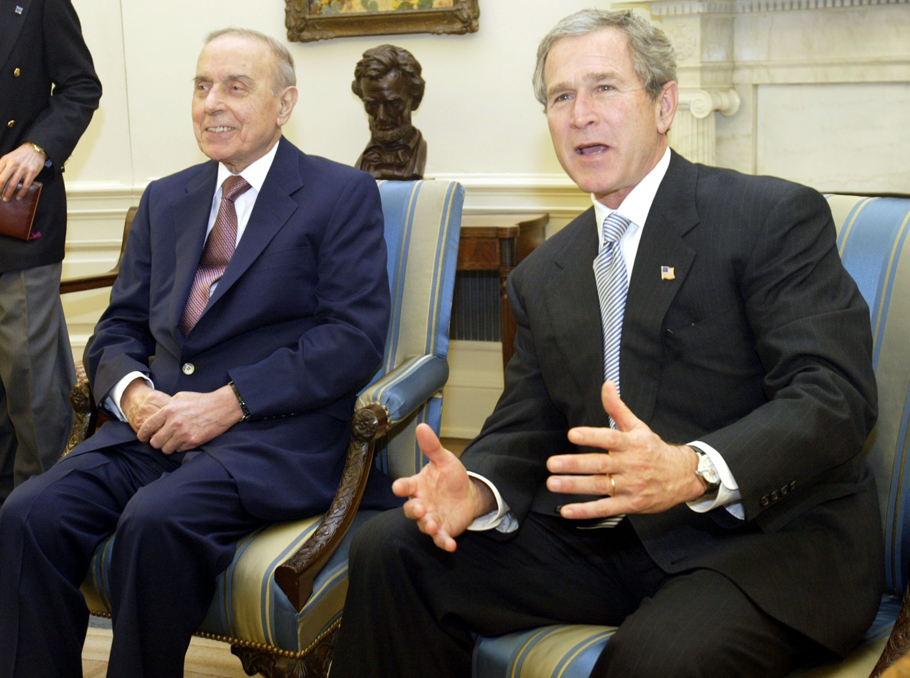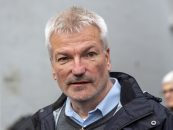By Rovshan Pashazadeh
Individuals and statesmen create history — historians write it.
The life of Heydar Aliyev covers more than half of the Azerbaijan Republic’s history, beginning in 1918, when the first Azerbaijani Republic was established. Each page of the last 50 years of Azerbaijan’s history was created with the participation of Heydar Aliyev. Thirty-four years have passed since July 14th 1969 when Heydar Aliyev was elected the leader of Azerbaijan, then under Soviet Regime.
During this period, Heydar Aliyev became one of the most famous individuals in Azerbaijan’s politics and history. There are very few politicians or statesmen that could lead his people with as much love during such a long period. Not only Azerbaijanis, but the whole Turkic and Moslem world felt pride and love for him.
Furthermore, during the time of the Soviet Union, all people of the USSR saw their future leaders under his personality. While he was in US, he was compared with George Washington, in Japan with the old statesmen and creators of the state, in Germany with Adenhauer, in France with Charles de Gaulle, in UK with Churchill.
Regardless of who he was compared with, he was always considered a monumental historical figure. Why? Heydar Aliyev was a leader who did not follow any political system or ideology. If we examine historical figures up to now, we see that each of them was a hero, a leader of a political system and a concrete historical process.
For example, The Great Pyotr was a leader of Tsarist Russia in the 18th century. He conducted reforms in the framework of a socio-political system in Russia. As General of the Ottomans, Mustafa Kamal Ataturk defended Turkey from foreign invaders and created an independent Turkish Republic at the beginning of 20th century.
Lenin and Stalin were leaders during the Soviet era, while Roosevelt and Churchill were leaders of the capitalist world. Some of them were written down in history as revolutionists, some as reformists, some as conservationists and some as dictators.
But Heydar Aliyev had characteristics belonging to none of them. His uniqueness was that as an historical individual he was both a leader as well as a hero of the Soviet period and the present-day. What was his secret? Why didn’t his views belong to a social-political system? How was he able to lead his people and state with such great love and capability under two different political systems and yet be accepted in the same degree by the world?
The writers of history characterize Heydar Aliyev as a great politician and statesman. Much is spoken about his capabilities and activities, but very little is mentioned about the theory of Heydar Aliyev, his ideology, his political statements and his views on management, science, theory and philosophy.
Azerbaijan historians, philosophers and political scientists have not yet been able to explain the main principles and characters of Heydar Aliyev’s ideology.
Today, many people speak about the existence of Heydar Aliyev’s political, economic management school and scientific-philosophy school, but none have been able to scientifically define Heydar Aliyev’s ideology.
Though some suggest a system of advanced views called “Aliyevism”1 they have difficulties in finding a precise scientific name for it. As noted before, historical figures create history but it is the historians and political scientists who write it.
The main function of historians is to write every historical reality objectively and conscientiously. The clear fact is that Heydar Aliyev spent more than 50 years of his life developing Azerbaijan under his name, so why is it necessary to define and name his ideas and the views of his theoretical ideology? Is it not better that his ideas remain etched in history as ‘Heydar Aliyevism’?
Indeed, what is ‘Heydar Aliyevism’? What principles and characters does this ideology consist of? As a statesman, while Heydar Aliyev was leader of Azerbaijan during both the Soviet and Independent periods, his opinions, speeches and statements reflect the main principles and characters of his ideology. Our duty is to read them carefully and then formulate a unique theoretical system. If historians don’t have the time or inclination to do so, then we, the people, should do it so that future generations can easily understand the scientific-theoretical principles of the establishment and development of an independent Azerbaijan.
So, what is “Heydar Aliyevism”? The principles and characters of this ideology consist of:
1. National Government
2. Reforms and legislation
3. National and moral values
4. Social justice and humanity
5. Internationalism and civilization
Before scrutinizing the first principle, let’s remember a sentence from one of his speeches: “A good government is not one that wants only to see its people happy, but one that is also able to bring it into effect by concrete methods”. In other words, a good state leader is not just someone who wants to see Azerbaijan independent and happy but one who can also accomplish it effectively, using contemporary methods.
Heydar Aliyev was a leader of the modern Azerbaijan Government. He was a leader of both the Azerbaijan people’s movement and the National Freedom Movement of Azerbaijan and National Statehood.
If we examine the activities of the leaders of the Azerbaijan State during the 20th century, we see that none of them served the Azerbaijan people and statehood as much as Heydar Aliyev. Between 1918 and 1920, when the first Independent Republic was established, the great individuals of Azerbaijan, M.A. Rasulzadeh, F. Khoyski, A. Topchubashov and others, served Azerbaijan very well.
But the life of the Republic lasted only a mere 23 months; they simply could not defend and maintain the independence of Azerbaijan under such an intensive internal socio-political and international situation. Thus, the Azerbaijan Soviet Socialist Republic was established. Men such as Narimanov, Musabayov, Agamalioglu, Sultanov, and others did their best to establish it.
When the USSR was established, N. Narimanov was one of the four chairmen of USSR Central Executive Committee representing the Caucasusian Republics. He was also a candidate of the bureau membership of Russia’s Communist Bolshevik Party. But neither N. Narimanov nor the others could raise their positions to members of the USSR Communist Party.
Although Narimanov wanted to support the independence of Azerbaijan, there existed some influence from Moscow. Heydar Aliyev, however, had been moving Azerbaijan toward independence step by step since 1970, when he was selected as Head of the Azerbaijan State.
In fact, the political-juridical, socio-political, moral-psychological bases of Azerbaijan’s independence were established by Heydar Aliyev between 1970 and 1980. In the Constitution received in 1978, the acceptance of the Azerbaijan language in the framework of the state was included in the attributes of an independent state.
Furthermore, the organization of a military school named by J. Nakhchivanski, the construction of industrial plants and factories, the preparation of professional individuals who were able to manage the state, the construction of high schools and other art and educational centers, were all the beginning of a move toward independence.
The powerful development of Azerbaijan’s economy during 1970-1980 was also one of the signs of independence. Between 1969 and 1970, national industry and industrial production more than doubled, productivity of labour doubled, agricultural produce increased by 270%, and the national consumption of goods tripled.
The changes happening in the economy showed that the improvement of the forces of production could not happen within the framework of a dependent country. An economy has its own rules.
The improvement of productive forces must concur with productive relations. Azerbaijan’s economic independence was becoming one of the main points of daily life while the Soviet productive relations were not able to regularize this strong development and the basis of this idea was being created by Heydar Aliyev.
Under the initiative of Heydar Aliyev, the most talented youngsters of Azerbaijan were sent to be educated in the various high schools of USSR and then returned to their motherland as highly qualified individuals between 1969 and 1980. These were people who were able to control today’s Azerbaijan. The newspaper, “Komsomolskaya Pravda”, issued an article indicating Heydar Aliyev’s early feelings about the destruction of the USSR.
In 1987, M.S. Gorbachov, a leader of USSR who wanted to separate Garabagh from Azerbaijan and join it to Armenia, cited Heydar Aliyev as the only power standing as a real prevention to his plan. After 40 days, a further problem relating to Garabagh was the start of a movement of people in Azerbaijan, of which it was said in Moscow that “Aliyevshina”2 was behind it.
Because of this movement, Gorbachov did his best to strive against “Aliyevism” with the help of local leaders of Azerbaijan such as A. Vezirov, A. Mutallibov, V. Aliyev and others. The idea was to keep the nation silent and make it dependent on Moscow by creating a puppet state.
Despite the tragedies of January 1990 in Baku and February 1992 in Khojali, the relinquishing of part of Azerbaijan to Armenia, and the subsequent Azerbaijani refugees, the Soviets could not achieve their goal. The reason they couldn’t was due to the strength of the movement developed by Heydar Aliyev and its active participants who were able to rally against the plans of Moscow.
When Aliyev was in Moscow, all the attention was on him. During the January tragedies in 1990, Heydar Aliyev made a statement about the Soviet Authority’s atrocious crimes with the help of local participators against Azerbaijanis, coming to the Azerbaijan Representative office in Moscow.
Aliyev condemned them for juridical and political crimes and was later discharged from the membership of the bureau of Soviet Union Communist Party and returned back to his motherland, “Nakhchivan”.
Thus, his return to Azerbaijan on 18th June, his departure to Nakhchivan, his election to Deputy of Azerbaijan Supreme Soviet and his election to Chairman of the Nakhchivan High Assembly, all led toward a movement which began in 1988, and in 1991 this culminated in the establishment of the National Freedom Movement.
The leader of this movement was none other than Heydar Aliyev because during the last 34 years, since he had become a member of the Government, Heydar Aliyev had evolved into the leader of the Azerbaijan nation without any alternative.
Wherever he was, and whatever his function was, the attention of people was always on him. In December 1982, when Heydar Aliyev was elected a member of the political bureau, and became the 1st Deputy Chairman of the USSR Soviet Ministry, a meeting to see him off was held at the art palace then named Dzerjinski (now named Shahriyar).
That meeting was broadcast by TV, in which it was easy to see the joyful and sorrowful tears of the people. Joyful, because it was the first time that a son of Azerbaijan could rise to such a high position, but sorrowful because he was leaving Azerbaijan. It was a real example of the people’s respect. Later, when Heydar Aliyev was discharged from his position in Moscow, all Azerbaijan people felt sorrowful.
Heydar Aliyev had not held a state position for three years in total and it was during that period that Azerbaijan suffered its worst problems. At that time most people admitted that if Heydar Aliyev had been Head of State, Azerbaijan would have been able to solve its problems easily.
In June 1990, returning to Nakhchivan, Heydar Aliyev soon returned to the political arena again. Since the day he was elected Deputy of the Azerbaijan Supreme Soviet, participating in the sessions of Supreme Soviet, he put forward the documents of the Constitution which eventually led to the acceptance of national independence.
He invited people not to vote for the authority of the Republic that wanted to keep the people under the dependence on USSR by conducting a referendum. The plans of power that aimed to separate Garabagh from Azerbaijan and join it to Armenia were broken up.
During the sessions of the Nakhchivan Supreme Soviet3, under Heydar Aliyev’s authority, essential documents proposing the independence of Azerbaijan were received. The building of the Nakhchivan Supreme Soviet where he sat, became the headquarters of the Azerbaijan National Freedom Movement. At that time there was a huge struggle for government in Baku, the capital of Azerbaijan.
The first President, Ayaz Mutallibov (1991-1992), who worked for Moscow, did not care about the independence of Azerbaijan. He fled to Moscow when the country was facing tragedy and war. After that, Abulfeiz Elchibey took control, and although supporting the independence of Azerbaijan, he was unaware how to achieve and maintain it, he was unable to fight against the powers staving off the independence, and he was weak against the demands of his environment, therefore he could not achieve Azerbaijan independence.
The aim in writing this is to remind the opposition powers who, using the phrases “People Movement” or “National Freedom Movement”, consider themselves the destroyers of USSR. The active participants and leaders of that movement must not forget that there is a significant difference between the leaders they name and the true leader of Azerbaijan. The true leader is the real head of the National Freedom Movement: the indispensable statesman, Heydar Aliyev.
Heydar Aliyev never intended to earn regard by using the words “nation, national government, independence, national union, national honor, national ideology” like other leaders during the Soviet period. On the contrary, unnoticeably, step by step, he took Azerbaijan to national independence with smart opinions and wise activities. After the destruction of USSR, taking a definite historical opportunity, he was the first to raise the independent flag.
He noted many times in his statements that the independence of the Azerbaijan Republic was an historical action. It is a national asset, an achievement of the Azerbaijan people and it should not be regarded as an activity of any group or movement’s work.
By accepting the truth of these words, we should note that the independence of Azerbaijan and its defense has been achieved only through Heydar Aliyev. We should also remember Aliyev’s words that the defense of Azerbaijan is rather more difficult than its independence.
The main conclusion of our 80-year history of independence, is that Heydar Aliyev was a statesman who was able to create and defend our independence – he was the leader of the Independent Azerbaijan Government. The main principle of Heydar Aliyev’s political activity was to provide interests of National Government of Azerbaijan.









